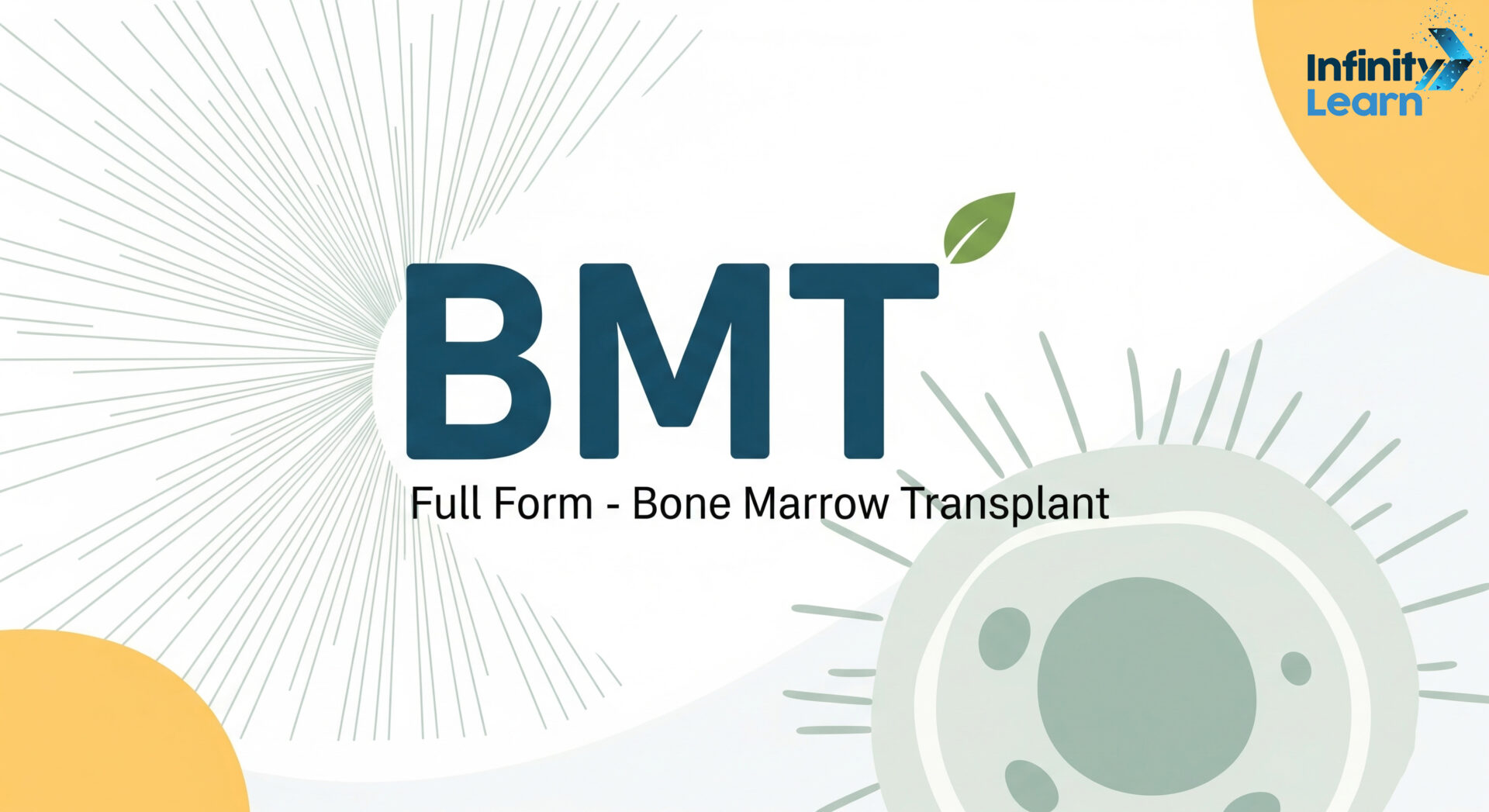Table of Contents
Bone Marrow Transplant (BMT) is a special treatment where sick bone marrow is replaced with a healthy one. Bone marrow is the soft part inside our bones that makes blood cells. BMT helps people with serious diseases like blood cancer or blood problems. Doctors use strong medicine before the transplant and put healthy cells into the body. It can come from the same person or a donor. BMT helps the body make new, healthy blood cells again.

What is the Full Form of BMT?
The full form is BMT is Bone Marrow Transplant (BMT).
What is Bone Marrow Transplant (BMT)?
Bone Marrow Transplant (BMT) is a special treatment where sick or damaged bone marrow is replaced with healthy bone marrow. Bone marrow is the soft part inside our bones. It makes red blood cells (which carry oxygen), white blood cells (which fight germs), and platelets (which help stop bleeding).
Doctors do BMT when a person’s bone marrow is not working well because of a disease or strong medicines like chemotherapy.
Do Check: AICTE Full Form
In this treatment, healthy bone marrow cells are taken from another person (a donor) or from the patient’s own body (if saved earlier). Then, these healthy cells are put into the patient’s body to help make new and strong blood cells.
Bone Marrow Transplant is used to help people who have serious illnesses like blood cancer (leukemia), lymphoma, or other blood problems.
Objectives of Bone Marrow Transplant
Check the key objectives of why doctors do a bone marrow transplant:
- Fixing Gene Problems in Some Diseases: Some people are born with blood problems like Thalassemia, Sickle Cell Disease, or weak immune systems. These happen because of faulty genes.
A bone marrow transplant can help fix these problems by giving new healthy cells with the right genes. This works best for young kids who get cells from a matching brother or sister.
- Helping After Strong Cancer Treatments: Sometimes, doctors use very strong medicines (chemotherapy) to kill cancer. But this also hurts the bone marrow.
A bone marrow transplant helps the body make healthy blood cells again. Sometimes, doctors use the person’s own healthy cells saved before the treatment. This is called an autologous transplant.
- Donor Cells Help Fight Cancer: In some cases, the new cells come from another person (a donor). These donor cells can help find and kill any leftover cancer cells.
Do Check: ADB Full Form
Common Conditions Treated with Bone Marrow Transplantation
Check these common health problems that doctors treat using a bone marrow transplant. These are serious conditions where new healthy cells can help fix or improve the body:
- Leukemia: This is a type of blood cancer. A bone marrow transplant is done when the cancer comes back or does not go away with normal treatment.
- Lymphoma: This is another type of blood cancer. A transplant is used when the cancer returns or is very hard to treat.
- Multiple Myeloma: This is also a blood cancer. A transplant helps the person live longer, even if it doesn’t fully cure it.
- Aplastic Anemia: In this disease, the bone marrow stops making healthy blood cells. A transplant gives new healthy cells to the body.
- Myelodysplastic Syndromes (MDS): These are problems where the bone marrow makes faulty blood cells. A transplant can help when symptoms like bleeding or infection become worse.
- Sickle Cell Disease: This is a disease where red blood cells are not shaped properly. A transplant can fix this by giving new, healthy red blood cells.
- Thalassemia: This is a problem with how the body makes hemoglobin in the blood. A bone marrow transplant can fully cure it, especially in young kids.
- Other Genetic and Autoimmune Disorders: Some people are born with problems in their genes or immune system. A transplant gives them new healthy cells when normal medicines don’t work.
Do Check: ACC Full Form
Types of Bone Marrow Transplantation
Bone marrow transplant can be done in different ways. The type depends on the patient’s disease and health.
- Autologous Bone Marrow Transplantation: In this type, doctors take stem cells from the patient’s own body. These cells are saved, and after the patient gets strong medicine (like chemotherapy), the saved cells are put back. This is used in diseases like leukemia, lymphoma, and multiple myeloma.
- Allogeneic Bone Marrow Transplantation: In this type, stem cells come from another person, like a brother, sister, parent, or even someone unrelated. The donor’s cells must match with the patient’s cells.Used when the patient’s bone marrow is badly damaged or very sick. Also used in diseases like sickle cell anemia and genetic problems.
- Cord Blood Transplantation: In this type, doctors use stem cells from a newborn baby’s umbilical cord. These cells are stored after birth and used when a good donor is not found. It takes more time for these cells to start working but is useful for small children.
- Syngeneic Bone Marrow Transplantation: This type is very rare. It is done when the patient has an identical twin. The twin gives the stem cells. Since twins have the same genes, there is almost no chance of rejection.
Do Check: ABG Full Form
Who Cannot Get a Bone Marrow Transplant?
Bone marrow transplant helps many people. But some people are not ready or healthy enough for it. Check bellow details to know who should not get it:
- Severe Infections
If someone has a very bad infection, they cannot get the transplant right away. Their body is too weak to fight germs during the treatment.
- Organ Failure
If the heart, liver, kidney, or lungs are not working well, the body may not handle the transplant. It can make the person sicker.
- Very Old Age
Old people can get tired easily. Their bodies may not heal well after the transplant. Still, doctors decide based on health, not just age.
- Other Serious Health Problems (Comorbidities)
People with very high sugar (diabetes), high blood pressure, or other long-time sickness may not do well after the transplant. Doctors will check if the body is strong enough.
- No Matching Donor (For Allogeneic Transplant)
Some people don’t have a brother, sister, or other match for donor cells. Without a match, the transplant can be risky.
- Cancer Not Getting Better
If the cancer is very strong and not going away with other medicines, the transplant might not work well. Doctors try to control the cancer first.
- Mental Health Problems
If someone is very sad, scared, or unable to understand the treatment, they might not be ready for a transplant. Doctors also check if the person is mentally prepared.
- Can’t Take Strong Medicine
Bone marrow transplant needs strong medicine before it begins. If the patient is too weak to take these medicines, doctors may not go ahead with the transplant.
Do Check: AAI Full Form
Procedure of Bone Marrow Transplantation
Bone marrow transplant is done in different steps. Check the following procedure:
- Before the Transplant: Getting Ready: Before the transplant starts, doctors do some tests to check if the patient is ready. Then the patient is given strong medicine called chemotherapy or radiation.This helps clean the old, sick cells from the body and make space for new healthy cells. This step takes a few days, and the patient stays in the hospital.
- Transplant Day: On the transplant day, the patient gets the new stem cells. These stem cells are given through a thin tube (called a catheter) into a vein, just like a blood transfusion.The new stem cells travel to the bone marrow and begin to grow. This step does not hurt and is easy like getting a drip.
- Care After the Transplant: After the transplant, the body becomes weak and needs extra care. The patient is kept in a very clean hospital room to avoid infections. Doctors do many checks to see if the patient is getting better.
- Monitoring: Doctors check blood, heartbeat, and organs every day.
- Medicines: The patient gets special medicines to stop infections and other problems.
- GVHD Protection: If the stem cells came from another person, the patient gets extra medicines so that the new cells do not attack the body.
- Engraftment (New Cells Start Working): This is the time when the new stem cells start to make healthy blood cells in the body. This usually happens 2 to 4 weeks after the transplant.Sometimes it can take longer. During this time, the patient is given extra care and sometimes more blood through transfusion.
Risks and Complications of Bone Marrow Transplantation
Bone marrow transplantation can help save lives, but it also has some risks and problems. Check the below information to know the risks and complications:
- Infections: After the transplant, the immune system becomes weak. This makes it easy for germs like bacteria, viruses, or fungus to make the person sick. These infections can happen before or after the transplant.
- Graft-Versus-Host Disease (GVHD): In some cases, the donor’s cells think the patient’s body is not their own and start to attack it. This is called GVHD. It can affect the skin, liver, or stomach and can be mild or serious. Doctors give medicines to help control it.
- Organ Damage: The strong medicines and radiation given before the transplant can sometimes hurt important body parts like the liver, heart, kidneys, or lungs. Doctors try their best to keep the organs safe, but damage can still happen.
- Rejection of the Graft: Sometimes, the body may not accept the new stem cells. This is called graft rejection. It happens when the immune system doesn’t work well, and doctors give special medicines to help fix this.
- Bleeding and Anemia: After the transplant, it may take time for new blood cells to grow. This can cause bleeding or feeling very tired due to low red blood cells. Doctors may give a blood transfusion to help.
- Secondary Cancers: Very rarely, some people may get another type of cancer later in life because of the strong treatment they had during the transplant. Regular check-ups help find any problems early.
Do Check: AM and PM Full Form
FAQs on BMT Full Form
What does BMT transplant stand for?
BMT stands for Bone Marrow Transplant, a treatment to replace damaged or sick bone marrow.
What is BMT full form?
The full form of BMT is Bone Marrow Transplant.
What is a bone test for BMT?
A bone test for BMT checks if your bone marrow is healthy or not before the transplant.
What are the two types of BMT?
The two types of BMT are autologous (your own cells) and allogeneic (cells from a donor).









